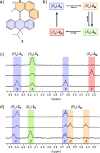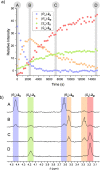Coupled Rocking Motion in a Light-Driven Rotary Molecular Motor
- PMID: 36223433
- PMCID: PMC10777401
- DOI: 10.1021/acs.joc.2c01830
Coupled Rocking Motion in a Light-Driven Rotary Molecular Motor
Abstract
Coupled motion is ubiquitous in Nature as it forms the base for the direction, amplification, propagation, and synchronization of movement. Herein, we present experimental proof for the coupling of the rocking motion of a dihydroanthracene stator moiety with the light-induced rotational movement of an overcrowded alkene-based molecular motor. The motor was desymmetrized, introducing two different alkyl substituents to the stator part of the molecular scaffold, resulting in the formation of two diastereomers with opposite axial chirality. The structure of the two isomers is determined with nuclear Overhauser effect spectroscopy NMR and single-crystal X-ray analysis. The desymmetrization enables the study of the coupled motion, that is, rotation and oscillation, by 1H NMR, findings that are further supported by density functional theory calculations. A new handle to regulate the rotational speed of the motor through functionalization in the bottom half was also introduced, as the thermal barrier for thermal helix inversion is found to be largely dependent on the alkyl substituents and its orientation toward the upper half of the motor scaffold. In addition to the commonly observed successive photochemical and thermal steps driving the rotation of the motor, we find that the motor undergoes photochemically driven rotation in three of the four steps of the rotation cycle. Hence, this result extends the scope of molecular motors capable of photon-only rotary behavior.
Conflict of interest statement
The authors declare no competing financial interest.
Figures







Similar articles
-
Coupling Rotary Motion to Helicene Inversion within a Molecular Motor.Angew Chem Int Ed Engl. 2025 Jan 21;64(4):e202416097. doi: 10.1002/anie.202416097. Epub 2024 Nov 26. Angew Chem Int Ed Engl. 2025. PMID: 39526696 Free PMC article.
-
All-Photochemical Rotation of Molecular Motors with a Phosphorus Stereoelement.J Am Chem Soc. 2020 Sep 30;142(39):16868-16876. doi: 10.1021/jacs.0c08249. Epub 2020 Sep 21. J Am Chem Soc. 2020. PMID: 32905701 Free PMC article.
-
Increased speed of rotation for the smallest light-driven molecular motor.J Am Chem Soc. 2003 Dec 10;125(49):15076-86. doi: 10.1021/ja036782o. J Am Chem Soc. 2003. PMID: 14653742
-
Excited State Dynamics in Unidirectional Photochemical Molecular Motors.J Am Chem Soc. 2024 May 8;146(18):12255-12270. doi: 10.1021/jacs.4c01019. Epub 2024 Apr 24. J Am Chem Soc. 2024. PMID: 38656968 Free PMC article. Review.
-
Amplifying Molecular Scale Rotary Motion: The Marriage of Overcrowded Alkene Molecular Motor with Liquid Crystals.Adv Mater. 2022 Oct;34(40):e2109800. doi: 10.1002/adma.202109800. Epub 2022 Sep 2. Adv Mater. 2022. PMID: 35732437 Review.
Cited by
-
Ligand-controlled regiodivergent arylation of aryl(alkyl)alkynes and asymmetric synthesis of axially chiral 9-alkylidene-9,10-dihydroanthracenes.Nat Commun. 2024 Oct 29;15(1):9307. doi: 10.1038/s41467-024-53767-4. Nat Commun. 2024. PMID: 39468097 Free PMC article.
-
Computational Study on the Dynamics of a Bis(benzoxazole)-Based Overcrowded Alkene.J Phys Chem A. 2025 Feb 6;129(5):1301-1309. doi: 10.1021/acs.jpca.4c06773. Epub 2025 Jan 23. J Phys Chem A. 2025. PMID: 39847760 Free PMC article.
-
A visible-light-driven molecular motor based on barbituric acid.Chem Sci. 2023 Jul 20;14(32):8458-8465. doi: 10.1039/d3sc03090c. eCollection 2023 Aug 16. Chem Sci. 2023. PMID: 37592992 Free PMC article.
-
Coupling Rotary Motion to Helicene Inversion within a Molecular Motor.Angew Chem Int Ed Engl. 2025 Jan 21;64(4):e202416097. doi: 10.1002/anie.202416097. Epub 2024 Nov 26. Angew Chem Int Ed Engl. 2025. PMID: 39526696 Free PMC article.
-
General strategy for boosting the performance of speed-tunable rotary molecular motors with visible light.Sci Adv. 2025 Feb 21;11(8):eadr9326. doi: 10.1126/sciadv.adr9326. Epub 2025 Feb 19. Sci Adv. 2025. PMID: 39970219 Free PMC article.
References
-
- Goodsell D. S.The Machinery of Life, 2nd ed.; Springer New York, New York, 2009.
LinkOut - more resources
Full Text Sources

